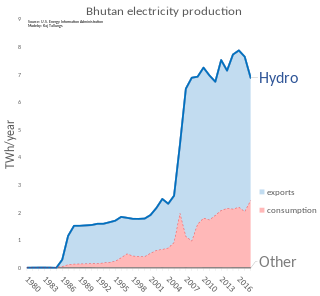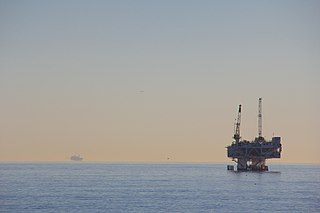Related Research Articles

Hydroelectricity, or hydroelectric power, is electricity generated from hydropower. Hydropower supplies one sixth of the world's electricity, almost 4,500 TWh in 2020, which is more than all other renewable sources combined and also more than nuclear power. Hydropower can provide large amounts of low-carbon electricity on demand, making it a key element for creating secure and clean electricity supply systems. A hydroelectric power station that has a dam and reservoir is a flexible source, since the amount of electricity produced can be increased or decreased in seconds or minutes in response to varying electricity demand. Once a hydroelectric complex is constructed, it produces no direct waste, and almost always emits considerably less greenhouse gas than fossil fuel-powered energy plants. However, when constructed in lowland rainforest areas, where part of the forest is inundated, substantial amounts of greenhouse gases may be emitted.

The electricity sector in Norway relies predominantly on hydroelectricity. A significant share of the total electrical production is consumed by national industry.

The Tanzania Electric Supply Company Limited (TANESCO) is a Tanzanian parastatal organisation established in 1964. It is wholly owned by the government of Tanzania. The Ministry of Energy and Minerals regulates the operations of TANESCO.

Brazil is the 7th largest energy consumer in the world and the largest in South America. At the same time, it is an important oil and gas producer in the region and the world's second largest ethanol fuel producer. The government agencies responsible for energy policy are the Ministry of Mines and Energy (MME), the National Council for Energy Policy (CNPE), the National Agency of Petroleum, Natural Gas and Biofuels (ANP) and the National Agency of Electricity (ANEEL). State-owned companies Petrobras and Eletrobras are the major players in Brazil's energy sector, as well as Latin America's.

Burning of renewable resources provides approximately 90 percent of the energy in Uganda, though the government is attempting to become energy self-sufficient. While much of the hydroelectric potential of the country is untapped, the government decision to expedite the creation of domestic petroleum capacity coupled with the discovery of large petroleum reserves holds the promise of a significant change in Uganda's status as an energy-importing country.

Energy in Mexico describes energy and electricity production, consumption and import in Mexico.
According to the International Hydropower Association, Canada is the fourth largest producer of hydroelectricity in the world in 2021 after the United States, Brazil, and China. In 2019, Canada produced 632.2 TWh of electricity with 60% of energy coming from Hydroelectric and Tidal Energy Sources).
Energy in Paraguay is primarily sourced from hydropower, with pivotal projects like the Itaipu Dam, one of the world's largest hydroelectric facilities. This reliance underscores the need for a robust infrastructure, including efficient transmission networks and distribution systems, to leverage the country's renewable resources fully.

The electricity sector of Uruguay has traditionally been based on domestic hydropower along with thermal power plants, and reliant on imports from Argentina and Brazil at times of peak demand. Over the last 10 years, investments in renewable energy sources such as wind power and solar power allowed the country to cover in early 2016 94.5% of its electricity needs with renewable energy sources.

Energy in Bhutan has been a primary focus of development in the kingdom under its Five-Year Plans. In cooperation with India, Bhutan has undertaken several hydroelectric projects whose output is traded between the countries. Though Bhutan's many hydroelectric plants provide energy far in excess of its needs in the summer, dry winters and increased fuel demand makes the kingdom a marginal net importer of energy from India.

Energy is a major area of the economy of California. California is the state with the largest population and the largest economy in the United States. It is second in energy consumption after Texas. As of 2018, per capita consumption was the fourth-lowest in the United States partially because of the mild climate and energy efficiency programs.

Georgia had a total primary energy supply (TPES) of 4.793 Mtoe in 2016. Electricity consumption was 11.5 TWh in 2016. Electricity production was 11.6 TWh, of which 81% from hydroelectricity and 19% from natural gas.
Uzbekistan had a total primary energy supply (TPES) of 48.28 Mtoe in 2012. Electricity consumption was 47.80 TWh. The majority of primary energy came from fossil fuels, with natural gas, coal and oil the main sources. Hydroelectricity, the only significant renewable source in the country, accounted for about 2% of the primary energy supply. Natural gas is the source for 73.8% of electricity production, followed by hydroelectricity with 21.4%.
Myanmar had a total primary energy supply (TPES) of 16.57 Mtoe in 2013. Electricity consumption was 8.71 TWh. 65% of the primary energy supply consists of biomass energy, used almost exclusively (97%) in the residential sector. Myanmar’s energy consumption per capita is one of the lowest in Southeast Asia due to the low electrification rate and a widespread poverty. An estimated 65% of the population is not connected to the national grid. Energy consumption is growing rapidly, however, with an average annual growth rate of 3.3% from 2000 to 2007.
The Mtwara–Dar es Salaam Natural Gas Pipeline (MDNGP), is a pipeline that transports natural gas from Tanzania's natural gas fields in Mnazi Bay, Mtwara Region to Dar es Salaam.
Julius Nyerere Hydropower Station is a hydroelectric dam under construction across the Rufiji River in eastern Tanzania. Although controversial, the government approved the plans in 2018. The power station is expected to have an installed capacity of 2,115 megawatts (2,836,000 hp) and to produce 5,920GWh of power annually. The project, power station and dam are owned by and will be managed by the government owned Tanzania Electric Supply Company (TANESCO). Construction began in 2019 and is expected to be completed in 2024.
Burning of charcoal and wood fuel provides approximately 94 percent of the energy in Malawi. Much of the renewable hydroelectric potential of the country is untapped. As per 2018 Population and Housing Census, the national electrification rate in Malawi was 10%, with 37% of the urban population and only 2% of the rural population having access to electricity.
Zambia is potentially self-sufficient in sources of electricity, coal, biomass and renewable energy. The only energy source where the country is not self-sufficient is petroleum energy. Many of the sources of energy where the country is self-sufficient are largely unexploited. As of 2017, the country's electricity generating capacity stood at 1,901 megawatts.
Ruhudji Hydroelectric Power Station is a planned 358 megawatts hydroelectric power station in Tanzania. The lead developer of this renewable energy project is Tanzania Electric Supply Company Limited (TANESCO), the government-owned electricity utility company. TANESCO plans to develop the power station, as a public private partnership (PPP) project. Work is contemporaneously ongoing, along with the development of the 222 megawatts Rumakali Hydroelectric Power Station, also located in Njombe Region.
References
- 1 2 3 "Energy Statistics Data Browser – Data Tools". IEA. Retrieved 2024-05-31.
- ↑ "Tanzania Energy Outlook – Analysis". IEA. Retrieved 2024-05-30.
- 1 2 Lake, Joseph. "Economy". In Frame, Iain, ed. (2013). Africa South of the Sahara 2014. Routledge. p. 51. ISBN 978-1857436983. OCLC 1087495.
- 1 2 Energypedia (2020). "Tanzania Energy Situation". Energypedia.info. Retrieved 15 July 2021.
- ↑ Babalwa Bungane (11 May 2020). "Tanzania records highest percentage in access to electricity". ESI-Africa. Rondebosch, South Africa. Archived from the original on 17 July 2021. Retrieved 15 July 2021.
- ↑ Babalwa Bungane (27 April 2017). "Solar power dominates rural Tanzania, says report". ESI-Africa. Rondebosch, South Africa. Archived from the original on 1 December 2020. Retrieved 15 July 2021.
- ↑ IRENA, International Renewable Energy Agency (2024). "RENEWABLE CAPACITY STATISTICS 2024" (PDF). www.irena.org. Retrieved 30 May 2024.
- ↑ Cities, Green Building Africa-Net Carbon Zero Buildings and (2024-05-19). "Second 235MW turbine commissioned at Tanzania's 2115MW Nyerere hydropower plant". Green Building Africa. Retrieved 2024-05-31.
- ↑ USAID (21 July 2021). "Tanzania Energy Sector Overview". United States Agency for International Development . Washington DC. Retrieved 15 July 2021.
- ↑ Gwladys Johnson (11 April 2016). "Tanzania aiming to become an energy exporter by 2018". Ecofin Agency. Retrieved 15 July 2021.
- ↑ MeTL Group (July 2021). "Energy & Petroleum: MeTL Group". MeTL Group. Dar es Salaam, Tanzania. Retrieved 15 July 2021.
- ↑ Dalbit Petroleum (15 July 2021). "Dalbit Petroleum Tanzania: About Us". Dalbitpetroleum.com. Dar es Salaam, Tanzania. Retrieved 15 July 2021.
- 1 2 International Trade Administration (9 March 2021). "Tanzania Country Commercial Guide: Energy Overview". International Trade Administration . Washington, DC. Retrieved 15 July 2021.
- ↑ Tanzania Invest (15 October 2015). "Mtwara-Dar es Salaam Natural Gas Pipeline Inaugurated". Tanzaniainvest.net. Dar es Salaam. Retrieved 15 July 2021.
- ↑ Reuters (11 June 2022). "Tanzania signs LNG framework agreement with Equinor and Shell". Reuters.com . Retrieved 24 August 2022.
{{cite web}}:|author=has generic name (help)